Abstract
This work analyzes the evolution of the large shifting dune included in the Corrubedo Natural Park from 1956 until the present day. The analysis was carried out using aerial images, orthophotographs, topographic surveys and LiDAR (Light Detection and Ranging) data. Variations were analyzed in terms of four different aspects: evolution of pathways in each period, changes in the position of the mobile dune front and the degree of vegetation cover, all between 1956 and 2017; and variations in elevation and volume of the dune system between 2001 and 2015. To analyze these aspects, geospatial and geostatistical techniques were employed, which revealed that the dune front had undergone two different phases: one until the 1980s, with a mean seaward advance of 32 m and another one between the 1980 s and 2017, when the front prograded to the continent, with an approximate mean advance of 82 m. Loss of volume, related to the expansion of the mobile dune towards the north, was confirmed in this sector. It is evident that these changes are closely linked to anthropic influence, due to sand extraction until the early 1990s and, more recently, due to an increase in the number of visitors to the Natural Park. The results obtained highlight the need to carry out detailed studies to understand the evolution of this system and to prevent further damage in the future. Moreover, based on these analyses, a strategy to improve coastal and environmental management in the Corrubedo Natural Park could be designed.
1. Introduction
Several publications have analyzed coastal dune systems, both at a global level and within Spain. Different authors have described the types of systems and their main characteristics [1,2,3,4]. Other works have focused on the dynamics and the evolution of these zones, particularly from a geomorphological point of view [5,6,7,8,9,10,11,12] but also paying attention to anthropic influence in these systems (e.g., References [13,14,15,16]). In this case the research focuses on an integrated analysis using different techniques in the large shifting dune within the Corrubedo Natural Park. This dune is 900 m long and 300 m wide and its maximum height is nearly 20 m. It is a singular formation in the Atlantic coast of the Iberian Peninsula.
Sedimentary systems are rapidly evolving environments, a fact with major implications both for the population and for economic sectors such as tourism [17]. In this sense and in relation to the potential impacts of global change, research about the evolution of sedimentary systems has become a key issue both for researchers and for society in general. The last few decades have seen an increase in the number of publications analyzing their evolution from multiple perspectives [18,19,20]. These variations are associated with technological advances, which have allowed researching this issue with a higher level of detail and accuracy [21,22,23].
The Corrubedo Natural Park is located in Galicia, a region in the NW Iberian Peninsula characterized by a very intricate coastline, with numerous inlets and outlets along more than 2100 km [24]. As the scale of analysis is expanded, the number of the different types of units identified increases. Among these, it is worth highlighting beach-dune systems, frequently associated with small lakes and marshlands, which constitute one of the most vulnerable coastal environments, as well as one of the most sensitive to human impact [25]. The study area could be included within this category. Overall, the Galician coast has been extensively analyzed from different perspectives in recent decades [26,27,28,29,30].
The main objective of this study is to analyze the evolution of the Corrubedo large shifting dune over a period of 60 years. This allows us to better understand their dynamics and to prevent the evolution of the dune sector. It aims to expand on the knowledge generated by previous analyses, such as pioneering studies by Vázquez Paz [31] and Delgado Blanco [32], in which the authors addressed geomorphological units, as well as by other research studies about the dune system [33], the beach rocks [34] and their evolution or about sections closely located to our study area [35,36], which have pointed out the influence of ancient topography and described the main characteristics of the system.
Corrubedo Natural Park as part of Nature 2000 network, the area occupied by the dune appear in the Plan Director de la Red Natura 2000 de Galicia (PDRN) (Decree 37/2014, Xunta de Galicia) with the habitat code 2120, as principal habitat and other dune habitats associated. This zone and the nearby habitats explain the importance of analyze Corrubedo system to improve the management of this area avoid possible problems related to the global change.
In line with the aforementioned, this work also reflects the importance of key factors, both of natural and human origin, for the existing variations in Corrubedo in order to measure the relevance of these factors for its past dynamics and their role in the present and future of Corrubedo. This is a key element since this study aims to lay the foundations for a more efficient management of the Corrubedo Natural Park.
2. Environmental Setting
The Corrubedo dune complex is located in the western edge of the O Barbanza peninsula (Figure 1), which separates the ria of Muros-Noia, in the north, from the ria of Arousa, in the south. It is a large sedimentary inlet delimited by low granitic cliffs and enclosed in its inner end by low elevations that do not exceed 300 m. Corrubedo is a singular system with a large sedimentary beach over 4 km in length and with an associated dune field that encloses a small lagoon and a marshland area with several meandering channels. The high environmental interest of this sector has led to its inclusion within the Natura 2000 network and to the creation of the Natural Park named Complexo dunar de Corrubedo e lagoas de Carregal e Vixán (hereinafter referred to as Corrubedo Natural Park) in 1992.
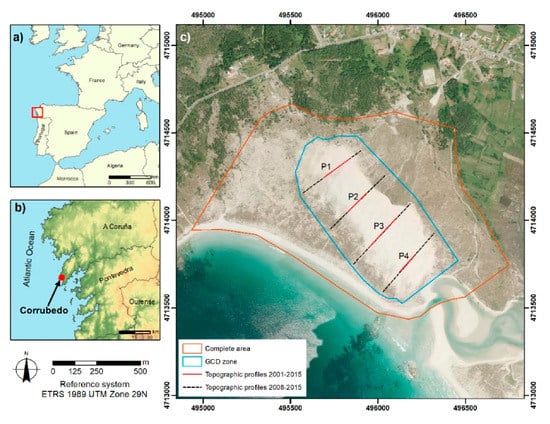
Figure 1.
Location map of Natural Park of Corrubedo. 9 (a) represent the area in European context; (b) shows Corrubedo in west Galicia area; and (c) shows the large dune and the analysis zona in detail with the polygons used for analyzing the elevation differences (Geomorphic Change Detection (GCD) zone); the area to analyzed the pathways (Complete area) and the topographic profiles position above PNOA 2017 orthophotography [37].
The Corrubedo Natural Park has a humid-oceanic climate, with an average yearly rainfall of 1000–1200 mm and mild temperatures all year round (18.5° in summer and 9.5° in winter) [38]. Winds vary in intensity and direction depending on the season. S and SW winds prevail in autumn and winter, in association with low pressures originated by the Polar front, which causes the majority of marine storms in this area. NW winds prevail during the summer, in association with anticyclones; winds during this season are persistent but with lower intensity than winter winds, with an average speed of 14 km/h.
Wave data were obtained from point no. 3010013 of the SIMAR network (Puertos del Estado [39]), located 4 km offshore to the south of the study area. The dominant wave direction is the West, which is the main orientation of the highest waves (Figure 2a), which occur during the winter months and frequently exceed 6 m in height (Figure 2c). Figure 2b shows the days with wave heights above Hs.95 (3.78 m), with a total of 280 days (4.28% of the analyzed period). This value evidences the importance of marine storms in this area, which constitute an essential erosive agent for the evolution of sedimentary systems, with values over 95%.
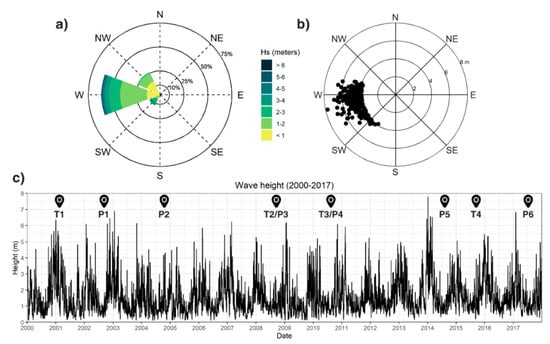
Figure 2.
Wave data about SIMAR point 3010013 between January 2000 and December 2017. (a) Wave rose with direction and height in percentage; (b) Direction and height of storm days defined as days with mean Hs > 0.95, in this period the Hs0.95 = 3.78 m; (c) Timeseries with mean daily Hs. Marks indicate the aerial images and orthophotographs date acquisition (starts with letter P and the entire code appear in Table 1) and the moment of topographic or LiDAR (Light Detection and Ranging) surveys (starts with letter T and the entire code appear in Table 2). Data from: Meteogalicia [38] and IGN (Instituto Geográfico Nacional) [37].
In the Corrubedo system, several geodynamic units can be distinguished between the upper beach and the continent, ranging from incipient dunes, whose genesis and evolution is related to hydrodynamic agents, to ancient dunes, which are fixed by vegetation. Vázquez Paz [31] carried out the first detailed cartography of these units, characterized their dynamic relations and analyzed environmental factors that influenced their recent evolution. In this sense and following the classification established by Paskoff [14], there is a sector of variable width composed by primary dunes, which receive sedimentary contributions and where two different categories can be distinguished: embryonic dunes, formed in the upper beach from berms or deposited material at the front of dune microcliffs and colonized by pioneer species such as Agropyrum junceiforme or Cakile marítima; and foredunes, which are sub-elliptic in plain view and generally follow a SW–NW direction, with Ammophila arenaria as the dominant species.
The group of secondary dunes includes a wide stripe of hummock dunes with 2–4 m in height. This geometry can result from crosswinds from the NW and SW, together with the protecting effect of vegetation. Towards the shore, the degree of vegetation coverage progressively increases, except in the vicinity of the mobile dune, where W winds carry sediments to this area.
On the back is the mobile dune, the main focus of this study, as well as a large sector of ancient dunes, with lower height and smoother shapes and fully colonized by vegetation. In some cases, these deposits can be reactivated due to high-intensity winds, and, particularly in the northern area, they are being covered due to the advance of the mobile dune.
The origin of the actual dune system could respond to a dune formation model during a marine regression phase [1]. According to faunistic and sedimentological results carried out by Margalef [40] in the ria of Vigo, the consequences of the last deglaciation first manifested in the Atlantic coast of Galicia around 8500–8000 years BP. Nevertheless, it was not until the maximum Flandrian transgressive phases that the sea retreated to levels slightly below the current ones. Accretion rates and wave, current and wind action in an environment with an important sedimentary stock enabled coastal sedimentary accumulations that allowed the beach to close, forming a lagoon. For 6000–6500 years BP, the processes of dune genesis and progressive closure of the lagoon occurred synchronically, with an expansion of the sedimentary barrier taking place around 5000 years BP [35].
The singular presence of a large transversal mobile dune (20 m high at its crest in 2000) occupying a secondary position in relation to the beach has been scarcely studied, particularly taking into account that coastal areas with similar climatic conditions, orientation and sedimentary stock are common throughout the NW Iberian Peninsula, yet accumulations of this magnitude have not formed in any of them. In the opinion of Vázquez Paz [31], its origin could be related to the existence of an orographic obstacle that would lead to sand accumulation. The dune formation process could have started during a phase of climatic transition, when sedimentary stock in the system was abundant due to a slight sea level rise that, as pointed out by Klijn [41], was also associated with an increase in the frequency and persistence of storms. During the Little Ice Age, wind intensity and frequency was significantly higher than in the present [41]. Due to this, accretion processes and the shoreward advance of the dune intensified. This fact generated the progressive expansion of the parallel corridor. It was a longitudinal dune created by SW fluxes and reshaped by NW winds.
In addition to natural factors, it is necessary to analyze human influence to understand the dynamics that explain the evolution of the system. Before the designation of this area as a Natural Park in 1992, different harmful activities had been carried out for decades in and around the large shifting dune, such as sand extraction from the dune and access of pedestrians and heavy vehicles to the dune system. These activities were of great importance in the decades of 1960 and 1970, in association with the boom of the construction industry. Sand extraction would not stop until the creation of the Natural Park, which in turn led to a substantial increase in the number of visitors. It is worth pointing out that the increased influx of visitors and the different structures created for tourism contributed to the alteration of the dune system. Among them, it is worth mentioning the construction of a wooden walkway over the mobile dune system in 2000, later removed in 2006 [33,42].
3. Materials and Methods
Given that this study covers a period of six decades, the consequent changes in available materials and research techniques have conditioned the development of this research. Due to this, three different and complementary data sources have been used.
The first source used were aerial photographs and orthophotographs from the IGN (Instituto Geográfico Nacional) [37] from years 1956, 1983, 1989, 2002, 2004, 2008, 2010, 2014 and 2017. Those from the first two study years were black and white aerial photographs, whereas those from years 1989–2004 were color aerial photographs and those from 2008 onwards were orthophotographs (Table 1). Based on them, variations in the different environments located in Corrubedo were analyzed.

Table 1.
Date of the aerial images and orthophotographs used.
The second data source was the topographic survey performed in this area in February 2001. This survey had a planimetric accuracy around 5 cm and an altimetric accuracy around 8 cm for recorded points and 20 cm for interpolated points. All data were obtained either from the main station or from auxiliary stations, always avoiding linking different auxiliary stations together.
Moreover, this research used LiDAR data [37] from years 2010 and 2015. This information had a resolution of 0.5 points/m2 and was obtained from the IGN. Additionally, data from our 2008 LiDAR flight, with a resolution of 0.3 points/m2, were employed (Table 2).

Table 2.
Date and type of surface elevation surveys.
Different methodologies and software were used depending on the type of analysis. ArcGIS 10.5 (license USC) was employed for geospatial processing and R software [43] was used for statistical analysis and for the majority of graphs.
To analyze variations in the mobile dune front, it was mapped for each date for which images were available. These lines were used as a proxy to quantify variations through DSAS (Digital Shoreline Analysis System) [44], whose validity was further corroborated by multiple studies about coastline evolution [26,45,46]. For this analysis, transects were generated every 5 m and variations were calculated in three different periods: first, between 1956 and 2017, in order to determine the changes throughout the whole study period; a second timeframe between 1989 and 2017, to determine the differences between the present and a moment when the configuration of the sector was already similar to the current one; and, finally, variations between 2004 and 2017 were calculated to understand the recent evolution and to estimate differences with a higher accuracy.
Variations in pathways were analyzed based on the images listed in Table 1. In this case, the detectable paths were first drawn and their length was then calculated within a 134.9 ha area around the mobile dune (Figure 1, orange line). This analysis aims to highlight the importance of human activities in this space since 1956.
As for plant coverage, the edges of the plant-covered areas were mapped for all years with available images (Table 1). Based on the generated polygons, the area covered by vegetation within the area delimited in Figure 1 was estimated and surface variations between dates were then calculated.
For the analysis of LiDAR data (2008–2015), Geomorphic Change Detection (GCD) implemented in ArcGIS [47] was used. In this case, a Limit of Detection (LoD) of 0.5 m, related to RMSE values of data acquisition, was estimated for the analysis of LiDAR data from 2008, while for data from 2010 to 2015, the LoD was established in 0.2 m, following specifications by the IGN [37]. This limit sets the minimum threshold for a variation to be considered as an actual change, therefore removing possible errors related to analysis uncertainty. This information was processed following the same methodology as previously described [26] and the area around the mobile dune was selected for research, with an overlapping area of 48.82 ha among all the different dates (Figure 1). In this area, the Difference of Digital Elevation Models (DoD) was calculated to estimate variations among the different years, both in terms of elevation and volumetrics.
In addition to this analysis of variations, topographic surveys were created, using data from 2008 to 2015 for a larger area and data from 2001, obtained from topographic surveys, for a smaller area focused on the dune crest. The aim of this process was to compare the 2001 profiles with the generated Digital Models (DM) based on the LiDAR data and to obtain a clear image of the variations in the crest of the mobile dune.
As a general approach, Figure 3 represents the workflow of this study. On the left side, the techniques and materials used are represented in green and, on the right side, the factors affecting changes in the system are represented in blue. These two elements were combined to attain the main purpose of this work: to determine the variations in the Corrubedo system since 1956 in order to improve the management of this area.
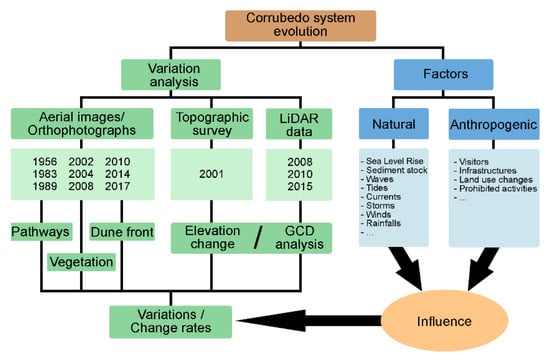
Figure 3.
Flowchart with the materials and steps of variation analysis and the main elements that could be influencing in the analyzed sector behavior.
4. Results
4.1. Pathway Analysis
The analysis of variations in pathways around the mobile dune showed a clear increase since 1956, reaching their greatest length in 2002, with 11,201 m. These values remained above 7000 m until 2010, at which point their length decreased down to 4986 m in 2017 (Table 3).

Table 3.
Pathway length (m) in each analyzed image.
This evolution was clearly related to an increase in the area covered by vegetation in Corrubedo, almost non-existent in 1956, although the fact that only black and white images were available for this date made it more difficult to map. As shown in Figure 4, plant coverage has been considerably higher from 2000 onwards than in previous decades. These images also illustrate important changes in pathway distribution, which have reduced in recent years and moved southward from the mobile dune, towards the middle section of the beach. This could be related to protection and control measures.
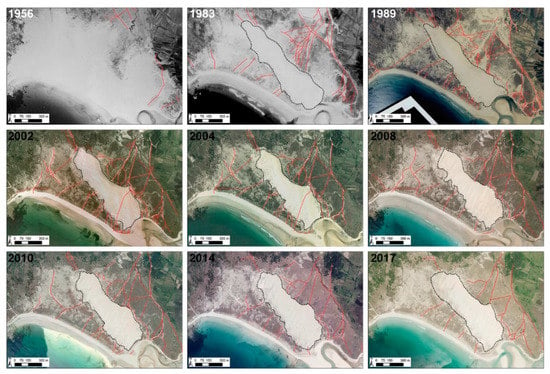
Figure 4.
Evolution of pathways in the large shifting dune sector since 1956 to 2017. The pathways (red lines) are on the aerial images and orthophotographs of each data where one can observe the variations in dune extension (black dashed line). In the case of 1956 image, the dune extension is not marked for the difficult to define their boundaries in that image.
It is also worth noting that the aerial images from 2002 and 2004 (Figure 4) showed a pathway across the large shifting dune. This element corresponds to the installation of a wooden walkway in this area, later removed, although some signs of its presence still remain in later images.
4.2. Variations in the Dune Front between 1956 and 2017
The analysis of the mobile dune front provided an opportunity to clearly identify its advance towards the north, occupying an area that had been previously covered by dune vegetation at least since the 1980s. Related to this process and to the analyzed DSAS processes are major differences in its behavior between the period from 1956 to the 1980s, on one hand and the subsequent period, on the other. For the overall period, an average progradation of 32.37 m offshore took place but this dynamic was largely due to the expansion of the area covered by vegetation with respect to 1956, when plant coverage in this sector was much lower and sand dominated the study area (Figure 4). Conversely, analyzing variations since 1989, the front of the large sifting dune could be observed to progress 81 m towards the shore. This advance was also clearly noticeable in recent years, exceeding 30 m since 2004 (Figure 5).
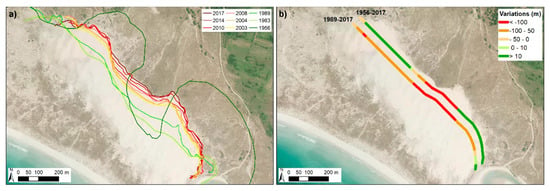
Figure 5.
(a) represents the front dune line in each analyzed year and (b) shows the variations of these fronts between 1956 and 2017 and between 1989 and 2017. Positive values indicated an advance to seaward while negative values indicate a variation to landward.
4.3. Variations in Vegetation Coverage
Vegetation coverage in Corrubedo also varied greatly over the analyzed period (Table 4), from 33 ha in 1956 to a maximum value of 93.9 ha in 2017. This increase in plant coverage was not linear: this area has remained above 80 ha since 2002, unlike in previous decades, according to the images used (Figure 6). This increase in vegetation coverage in dune zones has also been observed both in other areas of Galicia [48] and at a global level [49]. This could be related to a decrease in sedimentary activity linked to an increase in temperature and nutrients along with a decrease in winds, which enables the expansion of vegetation in these sectors [49].

Table 4.
Vegetation surface (ha) in each analyzed image.
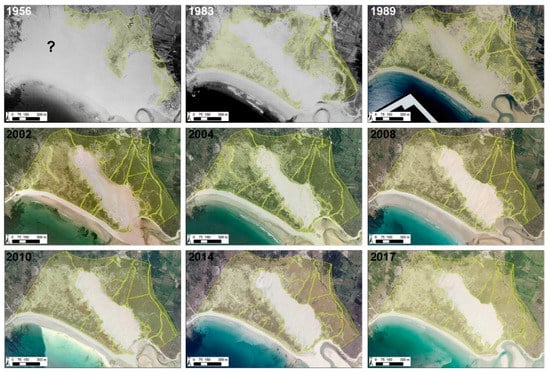
Figure 6.
Evolution of vegetation coverage since 1956 to 2017. The light green polygons represent the vegetation on the aerial images and orthophotographs of each data. The symbol (?) in this part of the Figure indicated that in that moment (1956) was not possible identify the large dune extension and their boundaries.
Additionally, it is worth highlighting that the accuracy of the definition of vegetation coverage based on older aerial images was lower, because coverage estimations always have a great uncertainty, especially in the case of the American flight (1956), where image quality complicates the delimitation of both the dune and the plant-covered area. In relation to the images, it is necessary to emphasize that the cartography based on images taken in different seasons, with the area having experienced different meteorological conditions in the months prior to image capture, can also lead to variations in the estimations due to the sand temporarily covering plants and to the seasonal behavior of some plant species.
Notwithstanding the foregoing, there has been a clear increase in plant coverage in recent years, which is perfectly consistent with the conclusions reached by other research studies [26,49].
4.4. Variations in Elevation Since 2001
Using data from the topographic surveys from 2001, from LiDAR (2008, 2010 and 2015) and from field visits during the last 20 years, an overall shoreward progradation of the dune could be observed, as already mentioned for the front dune. In this sense, a decrease in maximum elevation could be observed, with emerging evidence that the sediments are spreading northward, resulting in a decrease both in dune slope and in crest area. This advance leads to the fossilization of older plant-covered dune levels in some sectors (especially on the north side). Another effect was the progressive extension of the interdune corridor following an NNE-SSW direction, parallel to the dune crest, between it and the first level of plant-covered dunes located close to the beach (Figure 7 and Figure 8).
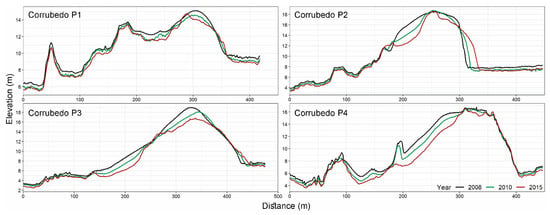
Figure 7.
Topographic profiles in dune mobile sector between 2008 and 2015. The position of these profiles appears in Figure 1c in black color.
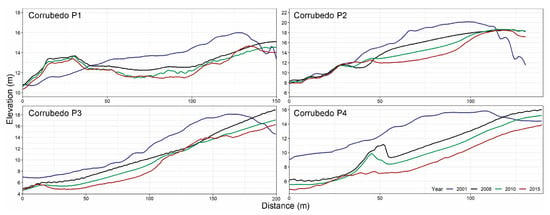
Figure 8.
Topographic profiles in the crest of dune mobile sector between 2001 and 2015. The position of these profiles appears in Figure 1c in red color.
As shown in Figure 7, a decrease in dune elevation occurred during the 2008–2015 period, especially in the crest. While in 2001 the maximum elevation was 21 m, this elevation decreased to 20.31 m in 2008, 19.59 m in 2010 and 18.51 in 2015. These modifications were more relevant in the central zone of the mobile dune (Corrubedo P2 and P3 in Figure 7), which corresponds to the highest sector and the one with the greatest amount of sediments.
To analyze variations since 2001, the analysis focused on the peak sector of the dune system, about which abundant information is available. As shown in Figure 8, elevation decreased across all profiles. This fact is related to the erosion of the seaward flank and shoreward dune progradation.
The analysis of LiDAR data from 2008 onwards showed a general decrease in elevation in the whole analyzed sector. The overall results showed that erosion was the dominant process in the seaward dune flank. In the inner flank, large accumulations of sand transported to the crest by deflation channels were formed, leading to movements caused by gravity that helped slow the progression of the dune towards the shore (Figure 9). In Figure 9, a clear increase in elevation related to the advance of the mobile dune is shown in green. This dynamic appeared in the system in the 1980s.
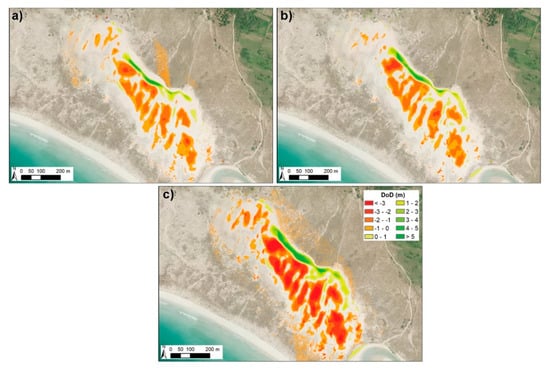
Figure 9.
Evolution of surface elevation in large shifting dune sector. (a) Difference of Digital Elevation Models (DoD) between 2008 and 2010; (b) DoD between 2010 and 2015; and (c) DoD between 2008 and 2015.
Between 2008 and 2015, a −0.55 m decrease in average elevation could be observed. A 74.8% proportion of the area experienced variations above the LoD (0.5 m for this period) and 83% of this area experienced a decrease in elevation, resulting in a volume loss of 269,481 m3. In the partial analysis for the period between 2008 and 2010, the area that experienced variations was 32% and elevation decreased in 80% of this area, resulting in a net volume loss of 99,124 m3. The net variation in elevation was −0.2 m. Finally, in the 2010–2015 period, a similar decrease in elevation took place, with an average decrease of −0.23 m, although the area that experienced changes above the LoD increased up to 70.9%, with 75% of the area experiencing loss. The net balance of volumetric change in this case was −110,317 m3.
5. Discussion
Compared with other sectors of the Iberian coast, the Corrubedo zone shows lower levels of environmental degradation. However, this sector has not been spared the effects of certain human activities that damage, sometimes irreversibly, their geomorphological and, consequently, their ecological and landscape balance [25].
One of the most relevant anthropic elements in Corrubedo was sand extraction for the construction industry. This practice led to a great reduction in dune volume, which is very difficult to quantify; at the same time, the loss of plant coverage reactivated erosion processes [41,50]. This illustrates how anthropic activities can contribute to modify natural dynamics. According to the available information, the designation of the Natural Park took place at a time when sediment extraction seemed to be generalized in this area, although this practice has been prohibited in Spain since the approval of a Coastal Regulation Law in the 1980s. The areas that were most affected by this activity were those easily accessed, particularly in the northeastern section and in the vicinity of the estuary, where the effects of this activity are still observable in the presence of ponds.
The legal protection applied to Corrubedo led to an improvement from the environmental point of view, since it reduced the most harmful activities in this area. Nevertheless, there are still some environmental conservation issues related to the number of visitors and their influence on the ecosystems. The pathways generated during the late 1990s could clearly be observed in some delicate and singular sectors such as the mobile dune (Figure 4). These events decreased with the imposition of fines to any person trespassing the security boundaries and accessing the mobile dune, although nowadays footprints in the dune can often be observed.
5.1. Installation of a Walway over the Mobile Dune
One of the variations related to the anthropic activity analyzed in this sector was the installation of a wooden walkway over the mobile dune in early 2000 [33,42]. This structure crossed the dune at the bottom of a deflation corridor in its southern sector, close to the estuary, which was one of the main sediment sources. A preliminary analysis showed that the installation of this walkway, composed of 15 cm wide crosspieces, caused changes at a small scale. Although the structure was flexible, its location interrupted the path of sediments transported by saltation or rolling. When the wind blew in an oblique direction, one side of the walkway acted as an accumulation zone (oriental sector), while on the opposite side, a centimetric scarp was originated and became the starter to a large-scale erosion spot. This fact led to the systematic covering of the structure in some parts, a clear sign of the importance of eolian transport in this area, where sediments were channeled to the center of the system.
It is evident that the installation of such structure caused a major perturbation in sand mobilization and, consequently, in the dynamic evolution of the mobile dune for years. Its installation also entailed an increase in the accessibility to the dune crest sector, enhancing its attractive as a slide (Figure 10).
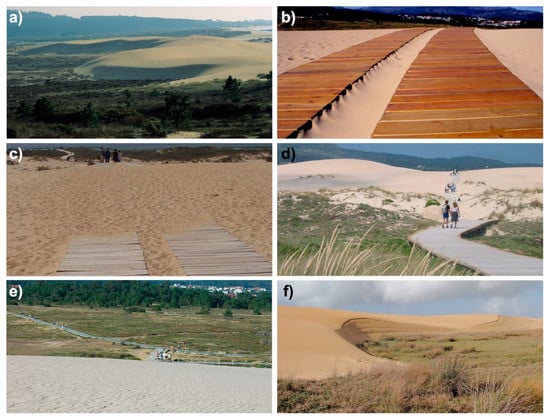
Figure 10.
Evolution of large shifting dune sector in different moments. (a) shows the dune sector in 1992; (b) shows the walkway in early 2000; (c) shows the walkway in 2002 cover in part for the dune evolution; (d) shows visitants in the walkway across the dune in 2002; (e) reveals the ripples in the dune zone and the new walkway position, without the across dune section in 2006; and (f) shows the state of large shifting dune in the sector close to the walkway in 2012, that clearly represent their progression.
In 2006, analyzing the different morphological units in the Natural Park following the removal of the wooden walkway, a certain degree of restoration of a natural dynamic could be observed in this sector, with the appearance of several ripples (Technical report, unpublished). Other fact worth highlighting is the increasingly natural progradation front. Even in August, the month with the highest influx of visitors, virtually no footprints could be observed on the slope, which could be partly related to the stricter surveillance in this sector.
5.2. Historical Variations in Sedimentary Systems
Corrubedo is not a paradigmatic case in the Galician nor in the international context [15]. Variations in sedimentary sectors have been widely studied around the world. Generally, these are sectors of great interest for activities such as tourism and their modification could have important effects on the local population [17,51]. Recently, the evolution of the sedimentary system of Rodas beach in the Cíes Islands was analyzed [26]. This area is located 40 km to the south of Corrubedo, in the mouth of the ria of Vigo. The changes observed in this system in recent decades show some similarities, such as sand extraction activities and increasing numbers of visitors, whose influence was perceived in the pathways they generated on plant-covered dunes [52].
This area underwent a paradigm shift in the last decades. While in the late 20th century, the damaging activities affecting this system were related to productive industries, such as construction, agriculture and farming around the lagoon sector [25], nowadays the main impacts in the Corrubedo area are related to tourism. Its beautiful landscape, along with the promotion of its most distinctive ecosystems, led to an influx of visitors to an area of great ecological fragility. Along the same lines, it is worth emphasizing the importance that other factors could have, such as N and NE winds, whose influence has been reduced due to the presence of buildings and shrub vegetation in the inner sector, as well as variations in wind flow due to the topography and roughness of dune sectors. In terms of natural factors, the increasing frequency and intensity of storms will play a relevant role in the future of the Corrubedo Natural Park.
Another aspect that has not been assessed but which directly affects Galician dune systems, were oil cleaning activities after the Prestige oil spill in 2002. It is worth mentioning their potential effect on Corrubedo, an area that received a major amount of hydrocarbons that directly affected the dynamics of species found in this area [53]. Other activities indirectly affected the evolution of the Corrubedo area through cleaning tasks in the area, the use of heavy machinery, the increase in transit of people for cleaning tasks and modifications to the system with the installation of sand and plastic barriers in sensitive areas, such as the Vixán lagoon.
5.3. The Importance of Coastal Management in the Future
Management is a key element in order to protect the evolution of the Corrubedo Natural Park and to avoid potential damage to this area. In this sense, further research is needed to identify the issues that affect the natural behavior of these fragile ecosystems and to design measures for their conservation and protection. Furthermore, a close collaboration between scientists and the administration is essential, following examples in other geographical areas, such as the case of coastal management in Scotland [54]. This fact could help to develop plans and regulations adapted to the present and future dynamics of the Corrubedo area.
Since the creation of the Natural Park and despite the measures announced for its conservation, multiple issues are still present, leading to a decrease in the quality of this system. Notwithstanding the presence of informative panels outlining the allowed and prohibited activities, some visitors still ignore these guidelines. In the mobile dune area, despite the existence of a signposted walkway, some visitors cross the established boundaries to directly access the beach.
The inclusion of this area within the Natura 2000 network should have simultaneously entailed the monitoring of the system’s evolution. In line with the aforementioned, it is necessary to analyze the zones included within the protected area and their definition. In some of these sectors, the elements described in management plans do not fully match the actual elements present in the field, which is an obstacle for their correct management. In addition to the revision of the described categories and their adaptation to the current state of the area, a periodical revision of said categorization is also necessary given the high dynamism of these ecosystems [55,56].
All the studies about the influence of different factors on system dynamics should address possible changes in the future, along with global change and the increase in erosive elements [57,58]. The Corrubedo Natural Park is highly vulnerable to a rise in sea level and to the increasing intensity and frequency of marine storms [59]. New technologies for gathering information and continuous improvements in processing tools are crucial for a better management of this zone in the future. Detailed monitoring of the system’s evolution helps to design management measures adapted to its needs. The application of new monitoring techniques, such as unmanned aerial vehicle (UAV) flights [60,61] or the installation of fixed cameras [62] to measure variations, could constitute an excellent tool to improve the conservation of the Corrubedo Natural Park.
6. Conclusions
The main conclusions of this study are:
- The mobile dune is progressively advancing towards the NE, especially in its middle section, while there is a decrease in maximum elevation and, especially, in the area occupied by the upper part.
- The decrease in elevation of the sedimentary sector is generalized: 83% of the surface experienced noticeable variations and elevation only increased in the progradation zone of the mobile dune.
- Anthropogenic influence is very important in the Corrubedo Natural Park, especially activities such as sand mining during the past century. Pathways have a great importance in this sector, although their length has decreased since 2002.
- The analyzed sector showed an important increase in vegetation coverage, especially since the 2000s. This fact is related with the greater presence of vegetation in sedimentary systems studied by several authors and in different regions.
- Visitors and introduced infrastructures have caused major impacts in the Corrubedo ecosystems in the last decades.
- It is necessary to monitor this system in detail to understand its current dynamics and to allow for a more efficient management.
Author Contributions
Conceptualization, A.P.-A., X.L.O. and A.G.-P.; methodology, A.P.-A. and A.G.-P.; formal analysis, A.G.-P. and A.P.-A.; investigation, A.P.-A. and X.L.O.; writing—original draft preparation, A.P.-A. and A.G.-P.; writing—review and editing, A.P.-A. and X.L.O. All authors have read and agreed to the published version of the manuscript.
Funding
The work of AGP is supported by an FPU predoctoral contract from the Spanish government (Ministerio de Educación, Cultura y Deporte). Grant Number: FPU16/03050. The Consellería de Educación, Universidade e Formación Profesional-Xunta de Galicia (Axudas á consolidación e estruturación de unidades de investigación competitivas do SUG del Plan Galego IDT, (Ambiosol Group, ref. 2018-PG036). The authors belong to the CRETUS Institute. All these programs are co-funded by FEDER (UE).
Institutional Review Board Statement
Not applicable.
Informed Consent Statement
Not applicable.
Acknowledgments
A.P.-A., A.G.-P. and X.L.O. are a part of the CRETUS Institute. We thank to Francisco José Delgado Blanco and Marina Vázquez Paz for their firstly investigations about the Corrubedo dune dynamics in the last years of the past century.
Conflicts of Interest
The authors declare no conflict of interest.
References
- Pye, K. Early post-depositional modification of aeolian dune sands. In Developments in Sedimentology; Elsevier: Amsterdam, The Netherlands, 1983; Volume 38, pp. 197–221. ISBN 0070-4571. [Google Scholar]
- Paskoff, R. Les dunes du littoral. Recherche (Paris 1970) 1989, 212, 888–895. [Google Scholar]
- Martínez, M.L.; Psuty, N.P.; Lubke, R.A. A perspective on coastal dunes. In Coastal Dunes; Springer: Berlin/Heidelberg, Germany, 2008; pp. 3–10. [Google Scholar]
- Hesp, P.A.; Walker, I. Coastal dunes. In Treatise on Geomorphology; Elsevier: Amsterdam, The Netherlands, 2013; pp. 328–355. [Google Scholar]
- Ritchie, W. The evolution of coastal sand dunes. Scott. Geogr. Mag. 1972, 88, 19–35. [Google Scholar] [CrossRef]
- Arbogast, A.F.; Hansen, E.C.; Van Oort, M.D. Reconstructing the geomorphic evolution of large coastal dunes along the southeastern shore of Lake Michigan. Geomorphology 2002, 46, 241–255. [Google Scholar] [CrossRef]
- Ojeda, J.; Vallejo, I.; Malvarez, G.C. Morphometric evolution of the active dunes system of the Doñana National Park, Southern Spain (1977–1999). J. Coast. Res. 2005, 49, 40–45. [Google Scholar]
- Pardo-Pascual, J.E.; García-Asenjo, L.; Palomar-Vázquez, J.; Garrigues-Talens, P. New methods and tools to analyze beach-dune system evolution using a Real-Time Kinematic Global Positioning System and Geographic Information Systems. J. Coast. Res. 2005, 49, 34–39. [Google Scholar]
- Fernandez, G.B.; Pereira, T.G.; da Rocha, T.B. Coastal dunes along Rio de Janeiro coast: Evolution and management. J. Coast. Res. 2009, 56, 307–311. [Google Scholar]
- Mathew, S.; Davidson-Arnott, R.G.D.; Ollerhead, J. Evolution of a beach–dune system following a catastrophic storm overwash event: Greenwich Dunes, Prince Edward Island, 1936–2005. Can. J. Earth Sci. 2010, 47, 273–290. [Google Scholar] [CrossRef]
- Bossard, V.; Lerma, A.N. Geomorphologic characteristics and evolution of managed dunes on the South West Coast of France. Geomorphology 2020, 367, 107312. [Google Scholar] [CrossRef]
- Molina, R.; Manno, G.; Lo Re, C.; Anfuso, G. Dune Systems’ Characterization and Evolution in the Andalusia Mediterranean Coast (Spain). Water 2020, 12, 2094. [Google Scholar] [CrossRef]
- Nordstrom, K.F.; Jackson, N.L. Distribution of surface pebbles with changes in wave energy on a sandy estuarine beach. J. Sediment. Petrol. 1993, 63, 1152–1159. [Google Scholar] [CrossRef]
- Paskoff, R. Typologie géomorphologique des milieux dunaires européens. Biodiversité Etprotection Dunaire Ates Du Colloq. Bordx. Paris 1997, 198–219. [Google Scholar]
- Cooper, J.A.G.; Alonso, I. Natural and anthropic coasts: Challenges for coastal management in Spain. J. Coast. Res. 2006, 48, 1–7. [Google Scholar]
- Ciccarelli, D.; Pinna, M.S.; Alquini, F.; Cogoni, D.; Ruocco, M.; Bacchetta, G.; Sarti, G.; Fenu, G. Development of a coastal dune vulnerability index for Mediterranean ecosystems: A useful tool for coastal managers? Estuar. Coast. Shelf Sci. 2017, 187, 84–95. [Google Scholar] [CrossRef]
- Pagán, J.I.; Aragonés, L.; Tenza-Abril, A.J.; Pallarés, P. The influence of anthropic actions on the evolution of an urban beach: Case study of Marineta Cassiana beach, Spain. Sci. Total Environ. 2016, 559, 242–255. [Google Scholar] [CrossRef]
- Pagán, J.I.; López, I.; Aragonés, L.; Garcia-Barba, J. The effects of the anthropic actions on the sandy beaches of Guardamar del Segura, Spain. Sci. Total Environ. 2017, 601–602, 1364–1377. [Google Scholar] [CrossRef]
- Robin, N.; Billy, J.; Castelle, B.; Hesp, P.; Laporte-Fauret, Q.; Lerma, A.N.; Marieu, V.; Rosebery, D.; Bujan, S.; Destribats, B.; et al. Beach-dune Recovery from the Extreme 2013–2014 Storms Erosion at Truc Vert Beach, Southwest France: New Insights from Ground-penetrating Radar. J. Coast. Res. 2020, 95, 588–592. [Google Scholar] [CrossRef]
- Ponte Lira, C.; Silva, A.N.; Taborda, R.; De Andrade, C.F. Coastline evolution of Portuguese low-lying sandy coast in the last 50 years: An integrated approach. Earth Syst. Sci. Data 2016, 8, 265–278. [Google Scholar] [CrossRef]
- Taddia, Y.; Corbau, C.; Zambello, E.; Pellegrinelli, A. UAVs for structure-from-motion coastal monitoring: A case study to assess the evolution of embryo dunes over a two-year time frame in the po river delta, Italy. Sensors 2019, 19, 1717. [Google Scholar] [CrossRef]
- Guisado-Pintado, E.; Jackson, D.W.T.; Rogers, D. 3D mapping efficacy of a drone and terrestrial laser scanner over a temperate beach-dune zone. Geomorphology 2019, 328, 157–172. [Google Scholar] [CrossRef]
- Kankara, R.S.; Selvan, S.C.; Markose, V.J.; Rajan, B.; Arockiaraj, S. Estimation of long and short term shoreline changes along Andhra Pradesh coast using remote sensing and GIS techniques. Procedia Eng. 2015, 116, 855–862. [Google Scholar] [CrossRef]
- POLGalicia Plan de Ordenación do Litoral de Galicia; Consellaría de Medio Ambiente, Territorio e Infraestruturas: Santiago de Compostela, Spain, 2010.
- Fraga-Santiago, P.; Gómez-Pazo, A.; Pérez-Alberti, A.; Montero, P.; Otero Pérez, X.L. Trends in the Recent Evolution of Coastal Lagoons and Lakes in Galicia (NW Iberian Peninsula). J. Mar. Sci. Eng. 2019, 7, 272. [Google Scholar] [CrossRef]
- Gomez-Pazo, A.; Perez-Alberti, A.; Otero Pérez, X.L. Recent Evolution (1956–2017) of Rodas Beach on the Cíes Islands, Galicia, NW Spain. J. Mar. Sci. Eng. 2019, 7, 125. [Google Scholar] [CrossRef]
- Gómez-Pazo, A.; Pérez-Alberti, A.; Trenhaile, A. Recording inter-annual changes on a boulder beach in Galicia, NW Spain using an unmanned aerial vehicle. Earth Surf. Process. Landf. 2019, 44, 1004–1014. [Google Scholar] [CrossRef]
- Trenhaile, A.S.; Perez-Alberti, A.; Martínez-Cortizas, A.; Costa-Casais, M.; Blanco-Chao, R. Rock coast inheritance: An example from Galicia, northwestern Spain. Earth Surf. Process. Landf. 1999, 24, 605–621. [Google Scholar] [CrossRef]
- Horacio, J.; Muñoz-Narciso, E.; Trenhaile, A.S.; Pérez-Alberti, A. Remote sensing monitoring of a coastal-valley earthflow in northwestern Galicia, Spain. Catena 2019, 178, 276–287. [Google Scholar] [CrossRef]
- Feal-Pérez, A.; Blanco-Chao, R.; Ferro-Vázquez, C.; Martínez-Cortizas, A.; Costa-Casais, M. Late-Holocene storm imprint in a coastal sedimentary sequence (Northwest Iberian coast). Holocene 2014, 24, 477–488. [Google Scholar] [CrossRef]
- Vázquez Paz, M. Geomorfología costera del sector Aguiño-Corrubedo; Universidade de Santiago de Compostela: Santiago de Compostela, Spain, 1998. [Google Scholar]
- Delgado Blanco, F.J. Aplicación da Análise Métrica ás Formas do Relevo; Universidade de Santiago de Compostela: Santiago de Compostela, Spain, 2003. [Google Scholar]
- Pérez-Alberti, A.; Vázquez Paz, M. Caracterización y dinámica de sistemas dunares costeros de Galicia. In Las Dunas de España; Scoiedad Española de Geomorfología: Zaragoza, Spain, 2011; pp. 161–185. [Google Scholar]
- Rey, D.; Rubio, B.; Bernabeu, A.M.; Vilas, F. Formation, exposure, and evolution of a high-latitude beachrock in the intertidal zone of the Corrubedo complex (Ria de Arousa, Galicia, NW Spain). Sediment. Geol. 2004, 169, 93–105. [Google Scholar] [CrossRef]
- González-Villanueva, S.; Costas, S.; Pérez-Arluecea, M.; Alejo, I.; Rial, F. Evolución del sector dunar sur del complejo de Corrubedo. Geogaceta 2011, 50, 177–180. [Google Scholar]
- Vilas, F.; Sopeña, A.; Rey, L.; Ramos, A.; Nombela, M.A.; Arche, A. The Corrubedo beach-lagoon complex, Galicia, Spain: Dynamics, sediments and recent evolution of a mesotidal coastal embayment. Mar. Geol. 1991, 97, 391–404. [Google Scholar] [CrossRef]
- Instituto Geográfico Nacional (IGN). 2020. Available online: https://www.centrodedescargas.cnig.es/ (accessed on 10 November 2020).
- Meteogalicia. 2020. Available online: https://www.meteogalicia.gal/ (accessed on 10 November 2020).
- Puertos del Estado. 2020. Available online: http://www.puertos.es/es-es (accessed on 8 September 2020).
- Margalef, R. Oscilaciones del clima postglacial del noroeste de España registradas en los sedimentos de la ría de Vigo. Zephyrus 1956, II, 5–9. [Google Scholar]
- Meur-Férec, C. Géomorphologie, Protection et Gestion Des Dunes de Bretagne Septentrionale: Éléments de Comparaison Avec D’autres Régions de la Manche Occidentale: Cotentin, Devon et Cornwall (RU). Ph.D. Thesis, Université de Bretagne Occidentale, Brest, France, 1993. [Google Scholar]
- Vázquez Paz, M.; Pérez-Alberti, A. Análisis dinámico y medioambiental de un espacio protegido en la costa atlántica (Parque Natural de Corrubedo, A Coruña). Xeográfica Rev. Xeogr. Territ. Medio Ambient. 2002, 2, 155–178. [Google Scholar]
- R Core Team. R: A Language and Environment for Statistical Computing. 2020. Available online: https://www.r-project.org/ (accessed on 7 September 2020).
- Himmelstoss, E.A.; Henderson, R.E.; Kratzmann, M.G.; Farris, A.S. Digital Shoreline Analysis System (DSAS) Version 5.0 User Guide; US Geological Survey: Reston, VA, USA, 2018.
- Sytnik, O.; Del Río, L.; Greggio, N.; Bonetti, J. Historical shoreline trend analysis and drivers of coastal change along the Ravenna coast, NE Adriatic. Environ. Earth Sci. 2018, 77, 779. [Google Scholar] [CrossRef]
- Brooks, S.M.; Spencer, T.; Mcivor, A.; Möller, I. Reconstructing and understanding the impacts of storms and surges, southern North Sea. Earth Surf. Process. Landf. 2016, 41, 855–864. [Google Scholar] [CrossRef][Green Version]
- Wheaton, J.M.; Brasington, J.; Darby, S.E.; Sear, D.A. Accounting for uncertainty in DEMs from repeat topographic surveys: Improved sediment budgets. Earth Surf. Process. Landf. 2010, 35, 136–156. [Google Scholar] [CrossRef]
- Otero, X.L.; Macías, F. Estudio para la sostenibilidad de la laguna de Baldaio y su entorno (A Coruña). In Litoral, Ordenación y Modelos de Futuro: IV Congreso de Ingeniería Civil, Territorio y Medio Ambiente; Dirección General de Costas; Ministerio de Medio Ambiente: Madrid, Spain, 2010. [Google Scholar]
- Jackson, D.W.T.; Costas, S.; González-Villanueva, R.; Cooper, A. A global ‘greening’ of coastal dunes: An integrated consequence of climate change? Glob. Planet. Chang. 2019, 182, 103026. [Google Scholar] [CrossRef]
- Bodere, J.C.; Hallegouet, B. Le cordon de Treffiagat (Finistere Sud): Les consequences d’une explotation abusive des sables dunaire. In Proceedings of the Les dunes Littorales et Leur Aménagement, Paris, France, 3 February 1990; pp. 45–56. [Google Scholar]
- Roig-Munar, F.X. Microerosión inducida por los usuarios de las playas. El caso de Menorca (Islas Baleares). Investig. Geogr. 2007, 43, 161–167. [Google Scholar]
- Costas, S.; Alejo, I.; Alcántara-Carrió, J. Human Influence on the Evolution of Islas Cíes Sand Barrier (NW Spain). In The Changing Coast; Eurocoast/EUCC: Porto, Portugal, 2002; pp. 283–287. [Google Scholar]
- Junoy, J.; Castellanos, C.; Viéitez, J.M.; Riera, R. Seven years of macroinfauna monitoring at Ladeira beach (Corrubedo Bay, NW Spain) after the Prestige oil spill. Oceanologia 2013, 55, 393–407. [Google Scholar] [CrossRef][Green Version]
- Fitton, J.M.; Hansom, J.D.; Rennie, A.F. A method for modelling coastal erosion risk: The example of Scotland. Nat. Hazards 2018, 91, 931–961. [Google Scholar] [CrossRef]
- Kovac, M.; Hladnik, D.; Kutnar, L. Biodiversity in (the Natura 2000) forest habitats is not static: Its conservation calls for an active management approach. J. Nat. Conserv. 2018, 43, 250–260. [Google Scholar] [CrossRef]
- Vanden Borre, J.; Paelinckx, D.; Mücher, C.A.; Kooistra, L.; Haest, B.; De Blust, G.; Schmidt, A.M. Integrating remote sensing in Natura 2000 habitat monitoring: Prospects on the way forward. J. Nat. Conserv. 2011, 19, 116–125. [Google Scholar] [CrossRef]
- Pickering, M.D.; Horsburgh, K.J.; Blundell, J.R.; Hirschi, J.J.M.; Nicholls, R.J.; Verlaan, M.; Wells, N.C. The impact of future sea-level rise on the global tides. Cont. Shelf Res. 2017, 142, 50–68. [Google Scholar] [CrossRef]
- Le Cozannet, G.; Bulteau, T.; Castelle, B.; Ranasinghe, R.; Wöppelmann, G.; Rohmer, J.; Bernon, N.; Idier, D.; Louisor, J.; Salas-y-Mélia, D. Quantifying uncertainties of sandy shoreline change projections as sea level rises. Sci. Rep. 2019, 9, 1–11. [Google Scholar] [CrossRef]
- Gómez-Pazo, A.; Pérez-Alberti, A. Vulnerability of the Galician coast to marine storms in the context of global change. Sémata Cienc. Sociais Hum. 2017, 29, 117–142. [Google Scholar]
- Turner, I.L.; Harley, M.D.; Drummond, C.D. UAVs for coastal surveying. Coast. Eng. 2016, 114, 19–24. [Google Scholar] [CrossRef]
- Green, D.R.; Hagon, J.J.; Gómez, C.; Gregory, B.J. Using Low-Cost UAVs for Environmental Monitoring, Mapping, and Modelling: Examples From the Coastal Zone. In Coastal Management, Global Challenges and Innovations; Academic Press: London, UK, 2019. [Google Scholar] [CrossRef]
- Harley, M.D.; Kinsela, M.A.; Sánchez-García, E.; Vos, K. Shoreline change mapping using crowd-sourced smartphone images. Coast. Eng. 2019, 150, 175–189. [Google Scholar] [CrossRef]
Publisher’s Note: MDPI stays neutral with regard to jurisdictional claims in published maps and institutional affiliations. |
© 2020 by the authors. Licensee MDPI, Basel, Switzerland. This article is an open access article distributed under the terms and conditions of the Creative Commons Attribution (CC BY) license (http://creativecommons.org/licenses/by/4.0/).